|
Hybrid Warbler (Mniotilta
x Vermivora -or- Mniotilta x Dendroica)
|

1
|
On May 14, 2005 at Metro Beach
Metropark, Macomb County, Michigan, I observed, tape recorded, then
captured and banded an unusual hybrid warbler. It was singing, thus was
likely a male, and a total of 15 photos were taken, all displayed below.
Comments were solicited from various internet chat groups, including
BIRDBAND and BIRD ID FRONTIERS.
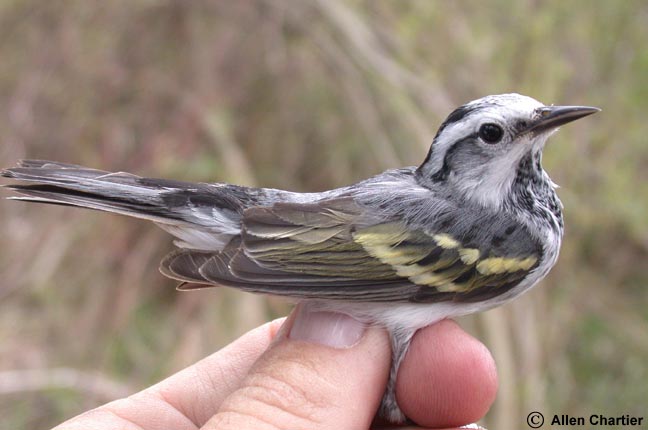
There seems to be general
agreement that one parent is Black-and-white Warbler (Mniotilta varia),
while opinions on the other parent are mainly split between Chestnut-sided
(Dendroica pensylvanica) and Golden-winged (Vermivora
chrysoptera), with "Brewster's" running a distant third.
Other possibilities suggested have included Black-throated Green (Dendroica
virens) and Black-throated Blue (Dendroica caerulescens), and
one suggestion was that this may be a pure Black-and-white Warbler showing
some leucism and/or xanthochroism.
Based on breeding habitat in
Michigan, it is perhaps more likely for a Black-and-white Warbler to pair
with a Chestnut-sided Warbler, and indeed the back pattern is suggestive
of Chestnut-sided, as is the wing pattern. But, the buzzy song is more
reminiscent of Golden-winged (and Brewster's) Warbler in quality, which
breeds in adjacent habitat to Black-and-white and though perhaps more
difficult for the two to pair, seems an equally likely scenario.
Measurements were as follows:
Wing Chord: 65.53 mm
Tail: 50.5 mm
Primary Projection: 14.0 mm
Exposed Culmen: 11.87 mm
Bill Depth at front of Nares: 3.20 mm
Bill Width at front of Nares: 3.52 mm
Tarsus: 17.44 mm
I wish to thank all who
provided input on this interesting bird, and am still soliciting opinions
and commentary. The photos are numbered to the left of each photo for ease
of reference. I also wish to thank Barb Beck for cleaning up my sound
recording, and for creating the Sonograms (click
here to go directly to the recordings at the bottom of the page)
.
|
| 2 |
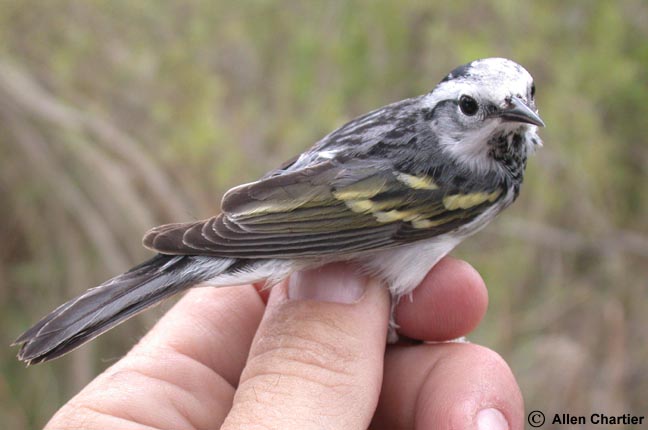
|
|
Note the head pattern similar to Mniotilta,
but with whitish forecrown, and yellow wing bars.
|
| 3 |
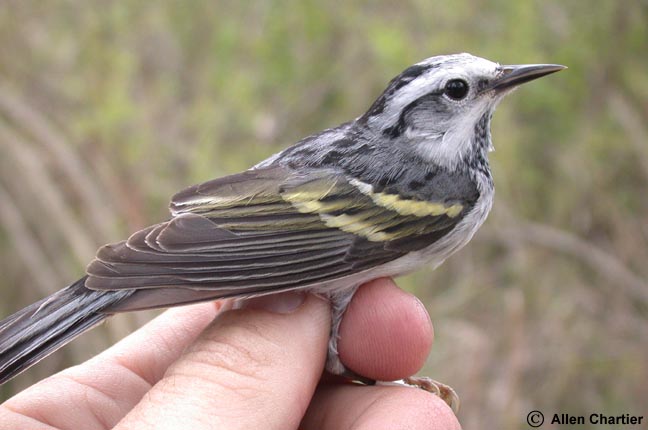
|
|
Directly from the side, the bill was most like Mniotilta,
perhaps longer, but clearly decurved and pointed.
|
| 4 |
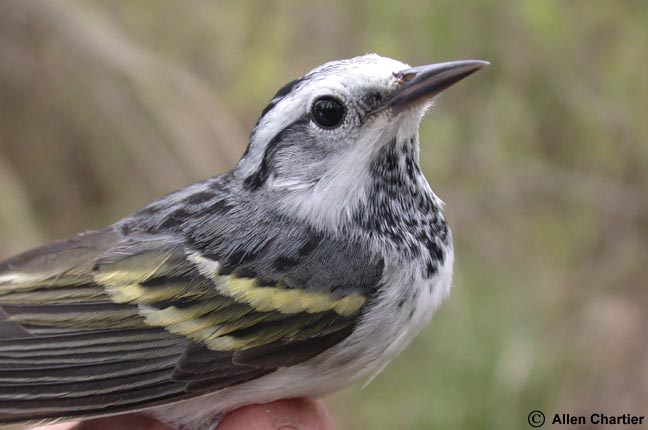
|
|
The white-edged black throat feathers are similar
to some second-year male Black-and-white Warblers. Note that the angle of
this photo gives the bill a more Dendroica-like appearance, an impression
that was not noted on the live bird in-hand.
|
| 5 |
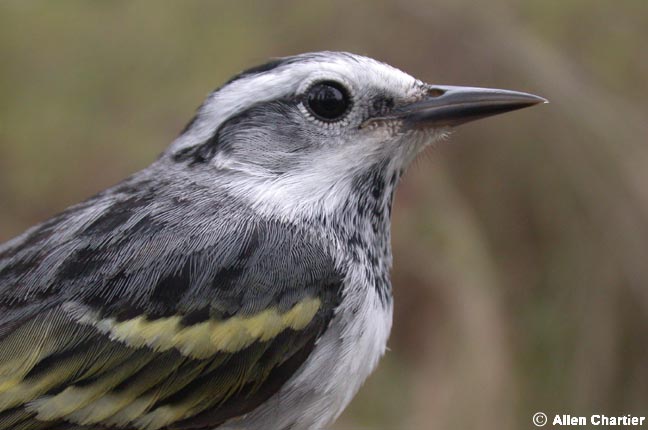
|
|
Another photo from slightly below, showing an
almost Dendroica-like appearance to the bill, not noted in the field,
and the mottled black throat. The gray cheek patch is most similar to adult
female or juvenile male Black-and-white Warbler, or adult female
Golden-winged Warbler.
|
| 6 |
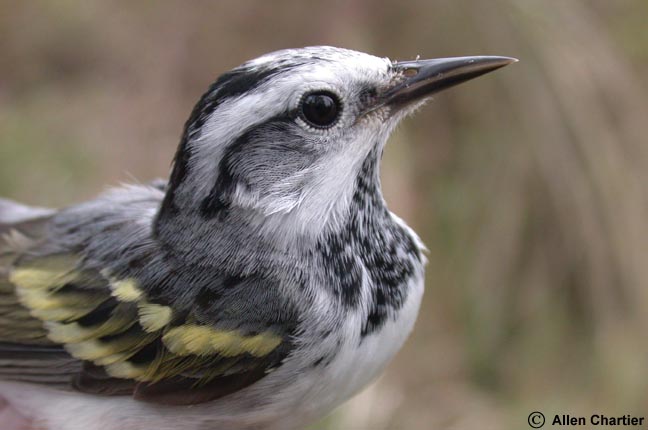
|
|
Again, in the field, the bill and head pattern was
very like Mniotilta.
|
| 7 |
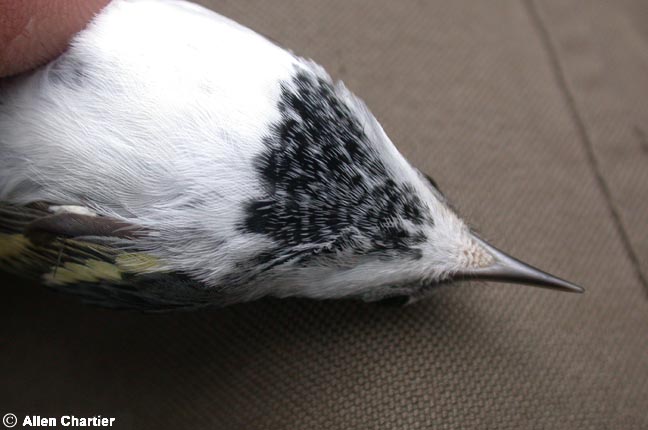
|
|
A closer view of the throat pattern. Also note the
thin and tapered bill.
|
| 8 |
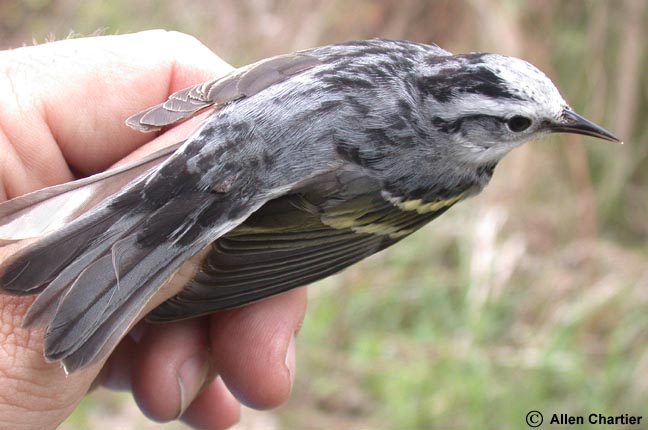
|
|
From above, the back pattern appeared somewhat
similar to that of Chestnut-sided, which has green feathers with large black
centers, where this bird has gray feathers with large black centers. The
black upper tail coverts may be more like Mniotilta. The whitish
forehead and crown patch is similar to both Golden-winged and Chestnut-sided
in shape and extent. Note the two broad black stripes on the hindcrown and
nape, split by a narrow gray median stripe, suggestive of Mniotilta.
|
| 9 |
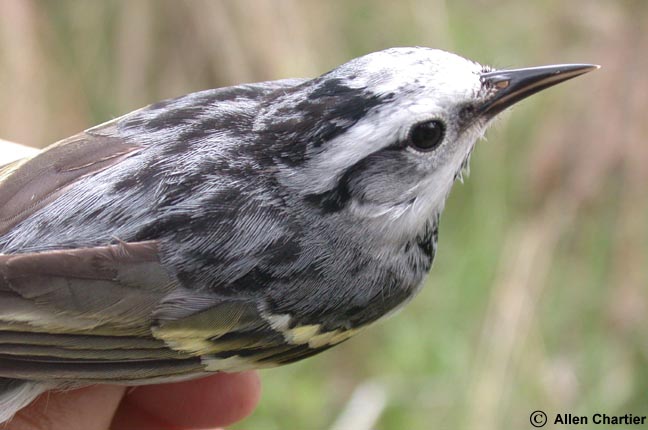
|
|
A closer look at the head and back pattern.
|
| 10 |
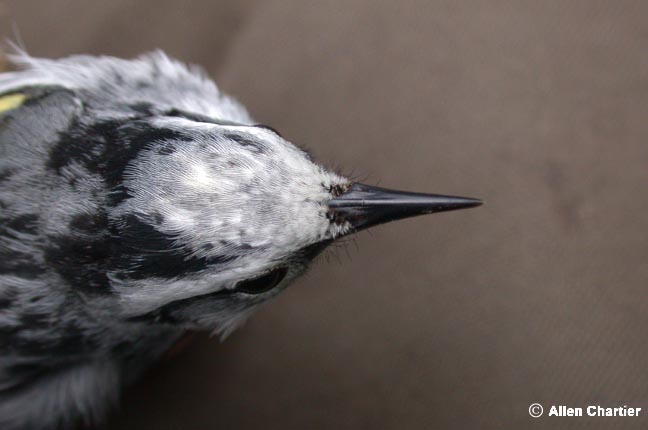
|
|
One feature that was visible on the bird in-hand,
but which does not show up in any of the photos, is a single pale yellow
feather in the center of the whitish crown.
|
| 11 |
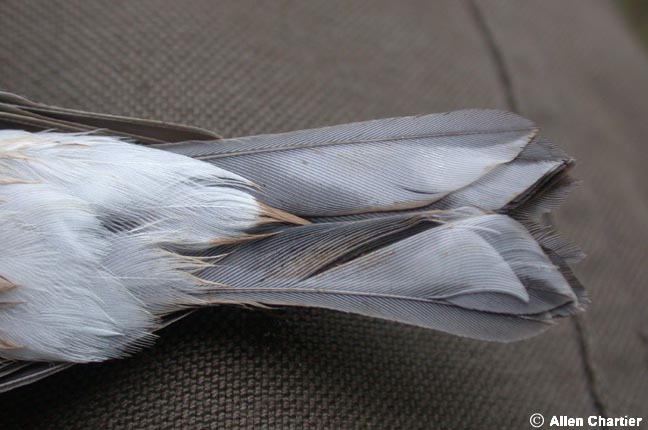
|
|
The tail from below showed fairly large white
spots. The rather pointed rectrices suggest perhaps this is a second year
bird, but given that this is a cross-genera hybrid, I'm reluctant to use
this as a definitive aging criteria.
|
| 12 |
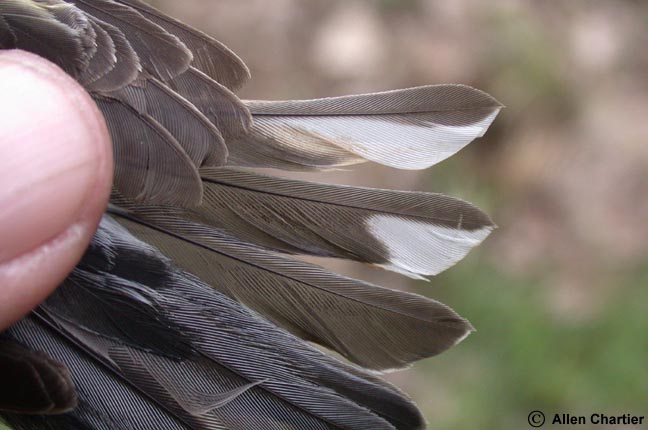
|
|
From above, the pattern of white on the outer
rectrices is perhaps most like Mniotilta.
|
| 13 |
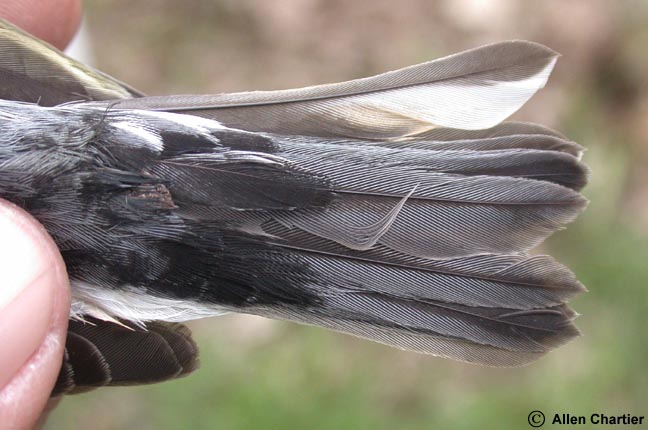
|
|
Another view of the tail from above, with the
feathers in a more natural position.
|
| 14 |
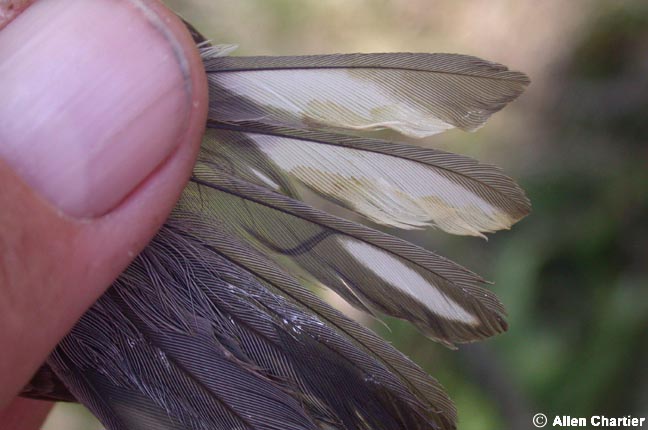
|
|
This is the tail of an adult female Golden-winged
Warbler for comparison. I do not have a similar photo of adult male, nor of
Chestnut-sided or Black-and-white. Such photos could be instructive.
|
| 15 |
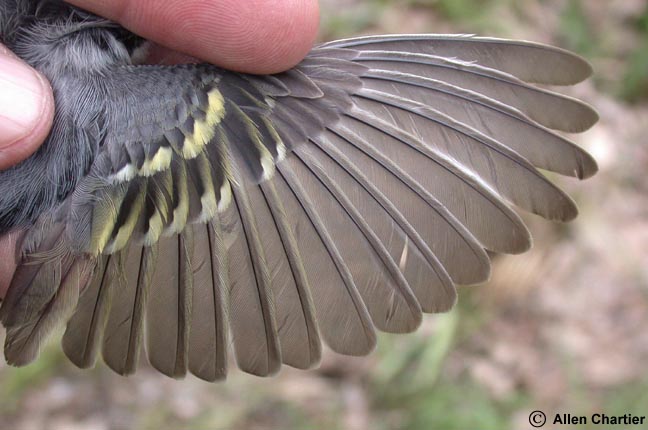
|
|
The open wing, showing details of the greater and
median secondary coverts which form the two yellow wing bars. Note the
single white tip on the innermost median covert, and some suggestion of
whitish on the outermost greater coverts. Also note the broad yellowish
outer edges of the greater coverts, which may be suggestive of
Golden-winged, though see comparison photos 16 and 17 below.
|
| 16 |
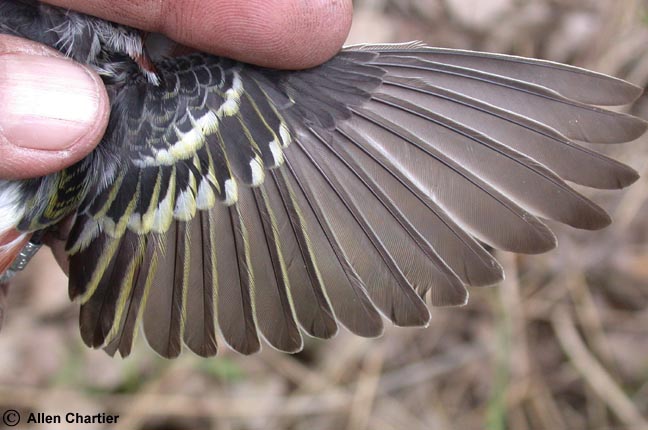
|
|
This Chestnut-sided Warbler (probably second year)
wing shows a superficially similar pattern to the hybrid, but the outer
edges of the greater secondary coverts are edged more narrowly with
greenish-yellow, and there is less yellow overall in the wing, so is not a
perfect match with the hybrid, but is pretty close.
|
| 17 |
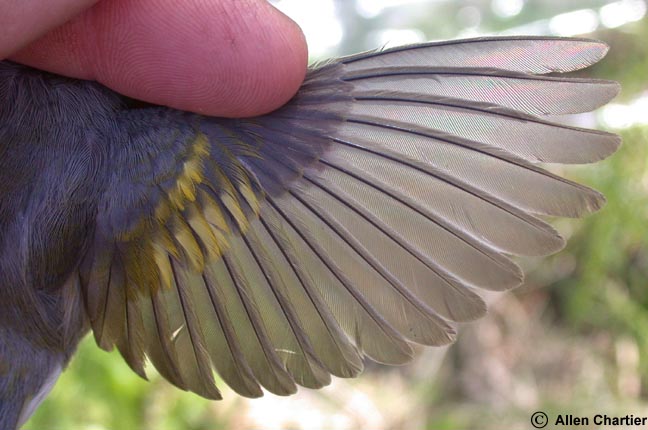
|
|
This Golden-winged Warbler (second year) wing shows
a pattern rather unlike the hybrid. I do not have a similar photo of an
adult male Golden-winged wing, but it is similar to this but with more
extensive yellow on the coverts.
|
| 18 |
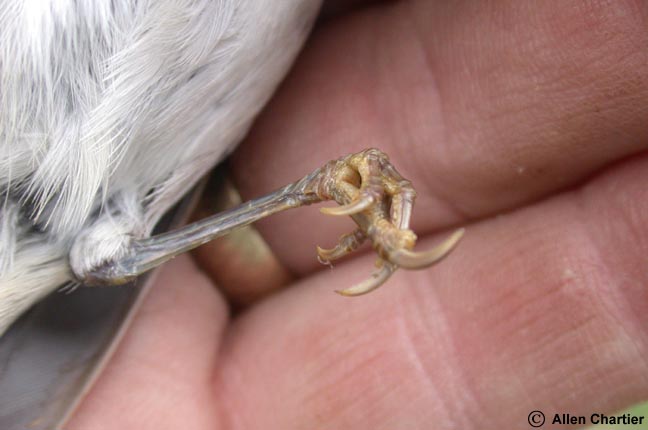
|
|
Just to be thorough, I photographed the birds feet
as well. The legs were dark grayish-brown, and the feet were orangish.
Offhand, I do not recall the leg and feet colors of any of the potential
parent species. The legs were sturdy, and the bird was a larger warbler,
requiring a size 0 band (using leg gage), rather than a size 0A taken by smaller-legged warblers
(like Golden-winged and Chestnut-sided).
|
|
|
|
Sound Recordings
Click HERE
to listen to the original of a single song (song 6 of 6) recorded of the
bird singing.
Click HERE
to listen to a filtered version of the same song (6 of 6).
Click HERE for a raw
version of a different song (2 of 6) from the series (much larger
file).
The bird foraged in a
willow tree about 20-30 feet above the ground in a manner similar to a Dendroica
or Vermivora, and not using larger branches in the manner of a Mniotilta.
Here is a sonogram of the filtered recording (6
of 6) included here.
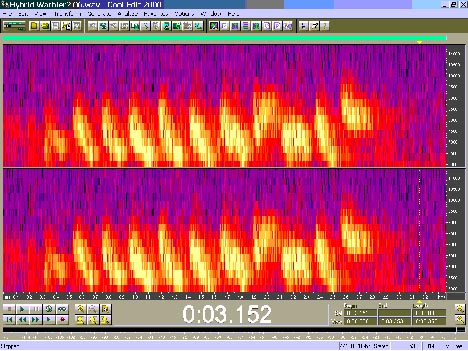
Here is an additional sonogram made from a
different song (4 of 6)
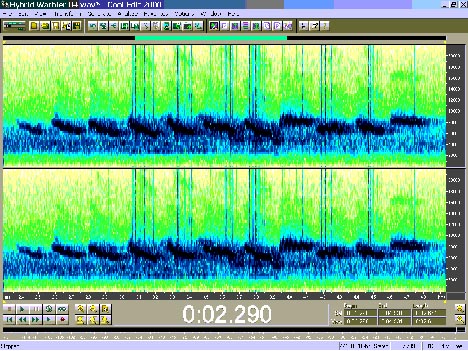
|



















